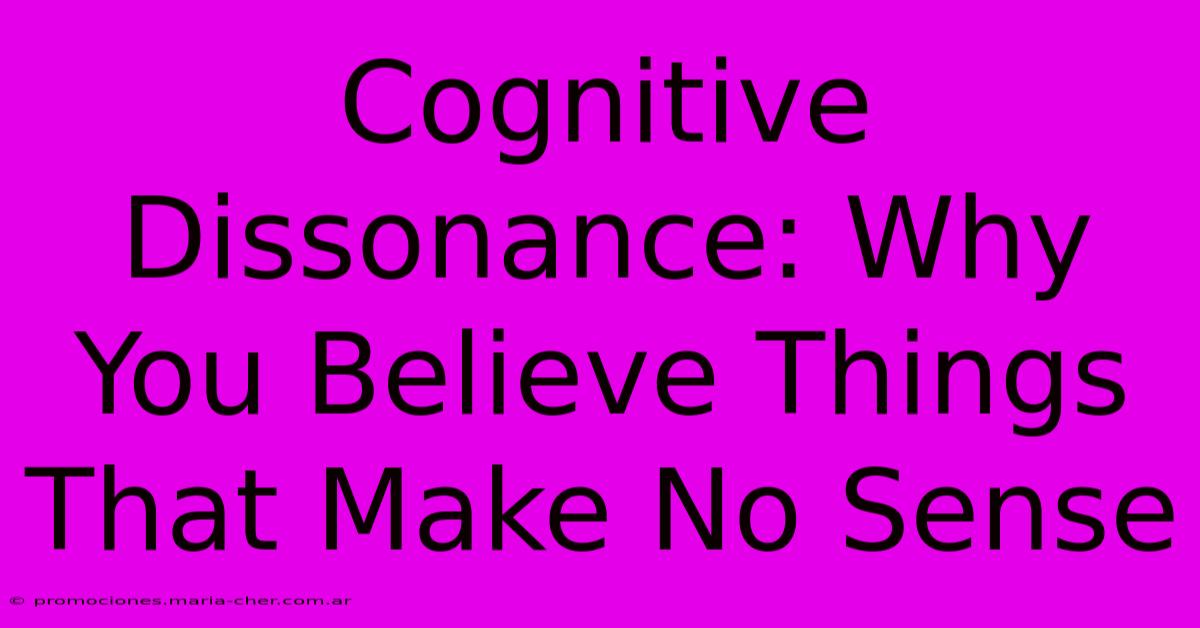Cognitive Dissonance: Why You Believe Things That Make No Sense

Table of Contents
Cognitive Dissonance: Why You Believe Things That Make No Sense
We all like to think of ourselves as rational beings, making decisions based on logic and evidence. But the reality is often far more complex. Our minds are masterful at justifying our actions and beliefs, even when those beliefs contradict logic or evidence. This fascinating mental phenomenon is called cognitive dissonance, and understanding it is key to understanding ourselves and the world around us.
What is Cognitive Dissonance?
Cognitive dissonance is the mental discomfort experienced by a person who holds two or more contradictory beliefs, ideas, or values. This discomfort arises when one's actions conflict with their beliefs, or when they are presented with information that challenges their existing worldview. The more significant the discrepancy, the greater the dissonance. Think of it as an internal alarm bell ringing, signaling a need for resolution.
Examples of Cognitive Dissonance in Everyday Life:
- The smoker who knows smoking causes cancer: They hold the belief that smoking is harmful yet continue to smoke. The dissonance is resolved through rationalization (e.g., "I'll quit tomorrow," "My grandfather smoked his whole life and lived to 90").
- The environmentally conscious person who drives a gas-guzzling SUV: They believe in environmental protection but own a vehicle that contradicts this belief. Dissonance might be reduced by focusing on other eco-friendly choices they make, or downplaying the SUV's environmental impact.
- The person who invests in a failing company: They believe in the company's potential despite mounting evidence suggesting otherwise. They might rationalize their investment by hoping for a turnaround or focusing on the potential rewards.
How We Reduce Cognitive Dissonance
Our minds are incredibly adept at reducing the discomfort of cognitive dissonance. We employ various strategies, often unconsciously, to restore internal consistency:
1. Changing Our Beliefs:
This is the most straightforward approach. We might acknowledge the evidence and adjust our beliefs accordingly. For example, a smoker might quit smoking after learning about the serious health risks.
2. Changing Our Actions:
Alternatively, we can alter our behavior to align with our beliefs. The environmentally conscious person might sell their SUV and buy a hybrid or electric vehicle.
3. Adding New Beliefs:
This involves justifying our actions or beliefs by adding new information that supports them. This is often done through rationalization or minimizing the importance of conflicting information. The investor in a failing company might find news articles that suggest a possible turnaround.
4. Trivializing the Dissonance:
We can downplay the importance of the conflicting information or our inconsistent actions. The smoker might say that the risk of cancer is exaggerated or that they enjoy smoking too much to quit.
The Power of Cognitive Dissonance in Persuasion and Marketing
Understanding cognitive dissonance is crucial in many fields, especially marketing and persuasion. Marketers often exploit this phenomenon to influence consumer behavior. For example, creating a sense of scarcity or highlighting a product's exclusivity can increase its perceived value and reduce the dissonance associated with a high purchase price.
Overcoming Cognitive Dissonance
While cognitive dissonance is a natural mental process, it can be detrimental if it leads to denial or the acceptance of misinformation. Developing critical thinking skills and a willingness to confront our own biases are crucial in mitigating the negative effects of cognitive dissonance. This includes:
- Seeking diverse perspectives: Actively seeking out information from multiple sources and viewpoints can help challenge our existing beliefs.
- Evaluating evidence critically: Learning to critically evaluate information, identify biases, and assess the credibility of sources is paramount.
- Embracing discomfort: Allowing ourselves to feel the discomfort of cognitive dissonance can open us up to self-reflection and personal growth.
Cognitive dissonance is a powerful force shaping our beliefs and behaviors. By understanding its mechanisms, we can become more aware of our own biases and make more rational and informed decisions. It's not about eliminating dissonance entirely, but rather managing it constructively for personal growth and a more accurate understanding of the world.

Thank you for visiting our website wich cover about Cognitive Dissonance: Why You Believe Things That Make No Sense. We hope the information provided has been useful to you. Feel free to contact us if you have any questions or need further assistance. See you next time and dont miss to bookmark.
Featured Posts
-
Photography On A Budget How The Sony Alpha 300 Dslr Delivers Professional Results Without Breaking The Bank
Feb 07, 2025
-
Gel Polish Revolutionized The Unbreakable Gel Polish Set For Chip Free Flawless Nails
Feb 07, 2025
-
Transform Your Space With An Abundance Of Babys Breath The Ultimate Guide
Feb 07, 2025
-
24x36 Inch Masterpieces Frame Your Memories In Cinematic Grandeur
Feb 07, 2025
-
Discover The Magic Of Shallow Depth Of Field With This Game Changing 50mm Lens
Feb 07, 2025
